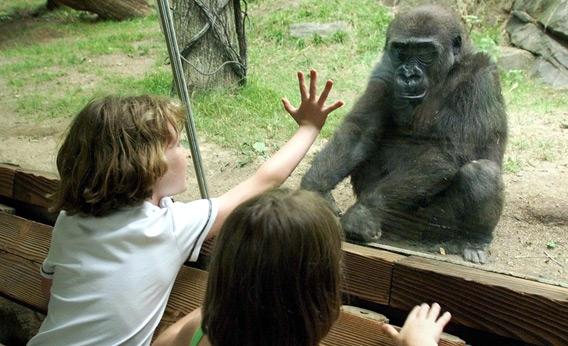Longform’s Best Science Stories of 2012
The Bronx Zoo, raising a micro-preemie, and a boy who achieved nuclear fusion.

This week, we’ll be sharing our favorite articles of the year on Slate. For our full list—including the top 10 of the year, plus picks in sports, politics, tech and more—check out Longform’s Best of 2012.

DON EMMERT/AFP/Getty Images.
Wild Things
David Samuels • Harper’s
Animal nature, human racism, and the future of zoos.
“At the zoo’s outdoor cafeteria, individual food items are advertised with the faces of animals whose habitats have been endangered by the mass consumption of junk food: the ring-tailed lemur advertises the specific kinds of wide-eyed insanity incarnated in the Madagascar Swurve, a slushy drink that reminds me of the cold cherry-flavored syrup I used to suck from soggy white paper cups of Italian ices in the summertime. A skewer of marshmallows costs $2.50. One more dollar and you get two graham crackers from a crinkly supermarket package along with three squares of a Hershey’s bar that is approximately the size of an elephant’s footprint. Then you take the skewers and hold them over open flames to make s’mores.
“Near the fire pits, a fat mom is yelling at her kid for wasting food. ‘You never, never, never waste food! Never!’ she instructs, in a scary tone of voice that is guaranteed to echo in the head of her future young diabetic. The Hasidic parents behind her are engaged in an odd-looking ballet, wheeling rickshaw-like contraptions that can carry three or four kids at a time. Their older children walk alongside the rickshaws in a parade of unseasonable black clothing that provides irrefutable evidence of the success of a communal experiment in rebuilding a human population that was systematically shot, gassed, and burned alive by their fellow humans. Below a footbridge, two slender gazelles butt heads, as a young boy standing alongside me unzips himself and sends a slender arc of golden urine into the illusory space of their enclosure.”
The Crayola-fication of the World: How We Gave Colors Names, and It Messed with Our Brains
Aatish Bhatia • Empirical Zeal
Vegetables are "blue" in Japanese and other observations on the uneasy relationship between color and language.
“In modern Japanese, midori is the word for green, as distinct from blue. This divorce of blue and green was not without its scars. There are clues that remain in the language, that bear witness to this awkward separation. For example, in many languages the word for vegetable is synonymous with green (sabzi in Urdu literally means green-ness, and in English we say ‘eat your greens’). But in Japanese, vegetables are ao-mono, literally blue things. Green apples? They’re blue too. As are the first leaves of spring, if you go by their Japanese name. In English, the term green is sometimes used to describe a novice, someone inexperienced. In Japanese, they’re ao-kusai, literally they ‘smell of blue’. It’s as if the borders that separate colors follow a slightly different route in Japan.
“And it’s not just Japanese. There are plenty of other languages that blur the lines between what we call blue and green. Many languages don’t distinguish between the two colors at all. In Vietnamese the Thai language, khiaw means green except if it refers to the sky or the sea, in which case it’s blue. The Korean word purueda could refer to either blue or green, and the same goes for the Chinese word qīng.It’s not just East Asian languages either, this is something you see across language families. In fact, Radiolab had a fascinating recent episode on color where they talked about how there was no blue in the original Hebrew Bible, nor in all of Homer’s Illiad or Odyssey!”
Never Let Go
[Part 1 • Part 2 • Part 3]
Kelley Benham • Tampa Bay Times
A three-part series on being the parent of a micro-preemie.
“Suddenly there was blood. Blood on my hands. Blood on a thin cotton hospital gown. Blood in red rivulets and blood in dark clumps. Bright beads of blood on the doctor's blue latex gloves. Blood in such startling quantity we could only imagine there was no life, no baby, not anymore.
“My obstetrician looked stricken that day in March 2011 when he rushed into a triage room at Bayfront Medical Center. I clenched and vomited as he explained that our baby had no chance of surviving outside the womb — if she wasn't already gone. A tech tried for long minutes to summon a heartbeat on the monitor, searching every quadrant of my abdomen. I don't remember if we held our breath or gasped or spoke or sobbed. I remember only the frozen shock when a heartbeat flooded the room, a sound like a galloping horse.
“In just a few hours, our baby had been lost and then found. On the monitor, she bobbed and floated in a pixelated haze. But next to her loomed a mysterious shape that had not been there two days before: a clot of blood the size of a fist, created as the placenta had begun to tear loose from my body. A nurse pumped drugs into an IV to stall the labor, and gradually they took a tenuous hold. But it was clear to everyone that the reprieve was temporary. My baby and I were coming apart.”
The Hazards of Growing Painlessly
Justin Heckert • New York Times Magazine
Ashlyn Blocker, 13, has a “congenital insensitivity to pain.”
“Tara and John weren’t completely comfortable leaving Ashlyn alone in the kitchen, but it was something they felt they had to do, a concession to her growing independence. They made a point of telling stories about how responsible she is, but every one came with a companion anecdote that was painful to hear. There was the time she burned the flesh off the palms of her hands when she was 2. John was using a pressure-washer in the driveway and left its motor running; in the moments that they took their eyes off her, Ashlyn walked over and put her hands on the muffler. When she lifted them up the skin was seared away. There was the one about the fire ants that swarmed her in the backyard, biting her over a hundred times while she looked at them and yelled: ‘Bugs! Bugs!’ There was the time she broke her ankle and ran around on it for two days before her parents realized something was wrong. They told these stories as casually as they talked about Tristen’s softball games or their son Dereck’s golf skills, but it was clear they were still struggling after all these years with how to keep Ashlyn safe.
“A couple of nights after telling me the story about putting her hand in the boiling water, Ashlyn sat in the kitchen, playing with the headband that held back her long brown hair. We had all been drawing on napkins and playing checkers and listening to Ashlyn and Tristen sing ‘Call Me Maybe,’ when all of a sudden Tara gasped and lifted the hair away from her daughter’s ears. She was bleeding beneath it. The headband had been cutting into her skin entire time we were sitting there.”
The Boy Who Played With Fusion
Tom Clynes • Popular Science
A profile of Taylor Wilson, who achieved nuclear fusion at age 14.
“As the guide runs off to fetch the center’s director—You gotta see this kid!—Kenneth feels the weight coming down on him again. What he doesn’t understand just yet is that he will come to look back on these days as the uncomplicated ones, when his scary-smart son was into simple things, like rocket science.
“This is before Taylor would transform the family’s garage into a mysterious, glow-in-the-dark cache of rocks and metals and liquids with unimaginable powers. Before he would conceive, in a series of unlikely epiphanies, new ways to use neutrons to confront some of the biggest challenges of our time: cancer and nuclear terrorism. Before he would build a reactor that could hurl atoms together in a 500-million-degree plasma core—becoming, at 14, the youngest individual on Earth to achieve nuclear fusion.”
For more of the year’s best writing, check out Longform’s Best of 2012.
